Best Way to Kill a Wasp in My House
It's a It's a perfect summer 24-hour interval and you're sitting exterior with your family unit grilling something delicious for dinner. Right then you hear it, a menacing buzz but over your shoulder. The wasps have arrived, and they're non leaving. They bulldoze you indoors, ruining your perfect afternoon.
Sounds familiar? You're not alone.
Each year, wasps take over outdoor spaces throughout the state, including the San Francisco Bay Surface area, making them hard or impossible for people to use.
Plus, wasps can exist dangerous.
According to the Centers for Disease Command and Prevention (CDC), there were i,109 deaths from hornet, wasp, and bee stings between 2000–2017, or an annual average of 62 deaths.
Fortunately, you don't take to resolve yourself to living with stinging wasps all summer. Smith's Pests Management is here to help you reclaim your property.
We provide yellow jacket control services to customers in and around the San Francisco Bay Surface area, then we know a matter or two about how to aid people get rid of wasps and start enjoying the outdoors once more.
In this blog, nosotros'll share a few of our top wasp removal tips and tricks, and insights on identifying common wasp species.
Permit'south dive in.
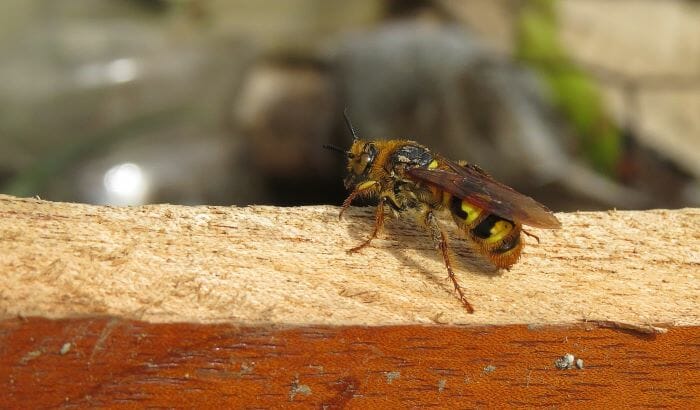
What Kind of Wasps Exercise I Take?
Wasps and their cousins, hornets and yellowjackets take nasty stings that tin can be especially dangerous to anyone allergic to them.
Even if y'all're not allergic to wasps, they tin can be a danger to anyone who gets too close to their nest. They will come up boiling out, often in large numbers, and immediately sting whatsoever person or pet who is nearby.
While some wasp species are highly ambitious, others are more docile. Some species, similar mud daubers, kill and eat other pest species, like spiders.
Since they help keep pest populations down, people can usually coexist with mud daubers (as long as they're in an out-of-the-fashion place where people and pets will not disturb them).
Because wasps comport so differently, y'all have to identify what kind of wasps you take before yous can start dealing with them.
With that in listen, hither's a breakdown of the most common wasp varieties: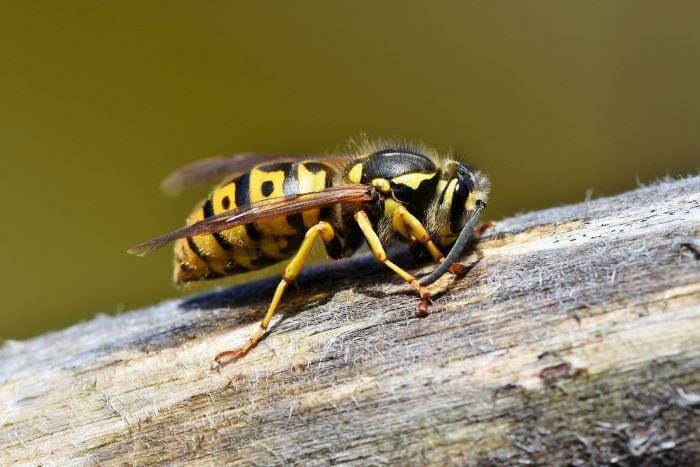
Xanthous Jackets
Yellow jackets are bee-sized wasps known for their singled-out blackness and yellow markings. They are common throughout the world and particularly abundant in the southeastern US.
Adults abound to almost ⅜" to ⅝." They live in colonies and build nests inside structures or on the ground to protect the group.
Paper Wasps
At ¾" to i" long, paper wasps are slightly larger than yellowish jackets. Their bodies are brown or black, with yellowish to red markings.
They live throughout Northward America, and usually build their nests near the shelter of buildings. Their nests are minor and only include a single layer of comb for breed rearing.
Like other wasp species, they volition not sting unless they experience threatened. While xanthous jackets are blackness and yellowish, newspaper wasps are brown and xanthous.
Hornets
In that location are about twenty species of hornets in the world. The varieties in California typically grow to about one.25." They tend to be black, with light yellow or white stripes that are more singled-out than those found on a xanthous jacket.
Hornets build hives by chewing woods into a papery pulp and using it to construct walls. About nests are congenital on high trees or sturdy, woody plants.
These wasps are highly social, and mostly will not sting unless they are threatened or provoked. When they are threatened, they swarm.
Mud Daubers
Mud daubers typically abound to ½" to 1" long. They are black, with vivid yellowish markings on their thorax and legs, and a long, sparse body that sets them apart from other wasp species.
While they're native to North America, they tin exist found throughout the globe. Unlike the other wasps on this list, they do not live in colonies or build nests with other wasps.
Instead, mud daubers utilize mud to build small nests for themselves and their offspring. They are a generally docile species and do non swarm like other wasps.
Bees vs. Wasps
While people often confuse honeybees and wasps, they are non the same creatures. While wasps are a pest species, honeybees are a keystone species that are critical to the surround.
Honeybees are a critically important species andnosotros do non recommend removing them from your yard or property.
Fortunately, there are a couple of ways to tell wasps and bees apart.
For example, bees are not aggressive, and can only sting in one case earlier dying. Wasps, on the other hand, tin can sting multiple times. Honeybees too have larger bodies and a light coating of downy hair. While both wasps and bees pollinate plants, honeybees are much more active pollinators than wasps.
What Attracts Wasps to My G?
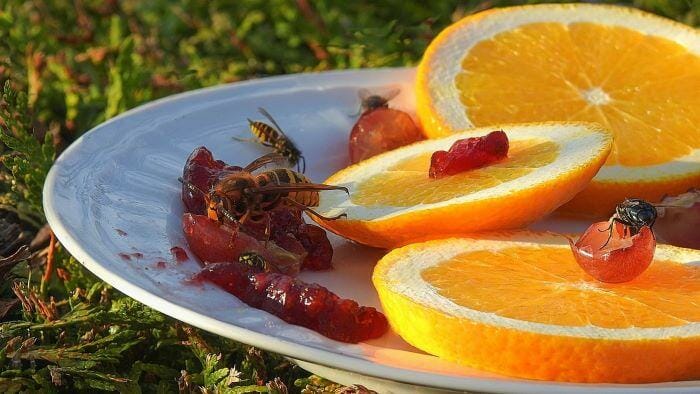
If you have wasps in your yard, y'all're probably wondering why they've chosen to pester you.
Here's the truth:
While wasps migrate through most every m from fourth dimension to time, the following things concenter them and entice them to stay:
i. Shelter
In the autumn, male wasps die after impregnating the colony's queen. The queen wasps then accept shelter in safe, warm, protected places where they survive the winter.
Wasps may exist hanging out in your thou because they've plant safe refuge there. Things like insulated walls, crevices, and cracks shelter wasps from potential predators and harsh elements.
2. Food sources
After hibernating all winter long, the queen and her workers emerge in preparation for the summer months. And after a long winter, they're hungry and looking for food sources. If they can find something to eat in your 1000 or garden, they'll stay.
Some wasps, known as digger wasps, will hover above the basis to prey on larvae, grubs, and other insects. Considering of this, 1 of the best ways to prevent a wasp infestation on your property is to get rid of other pest species like spiders showtime.
3. Food leftovers
While wasps hunt for some of their food, they too love a free repast when they can find it. They eat protein-based foods, and will scavenge leftovers similar meat scraps or grill drippings. While you lot can't proceed wasps from noticing your cookout altogether, you can discourage them from staying past covering your cooked food and cleaning up spills promptly.
iv. Carbohydrate
When autumn comes around, wasps start searching for sources of saccharide to become them through the winter. Wasps will seek out fallen fruit from trees, soda cans, hummingbird feed, fruit juice, and anything else that is a practiced source of sucrose.
5. Flowers
Wasps are attracted to flowering plants. They savour the nectar of the flowers and the fragrance, and tin quickly take over a garden bed. If yous wear strong perfume, they may also be attracted to that scent.
How to Get Rid of Wasps in Your Yard & House
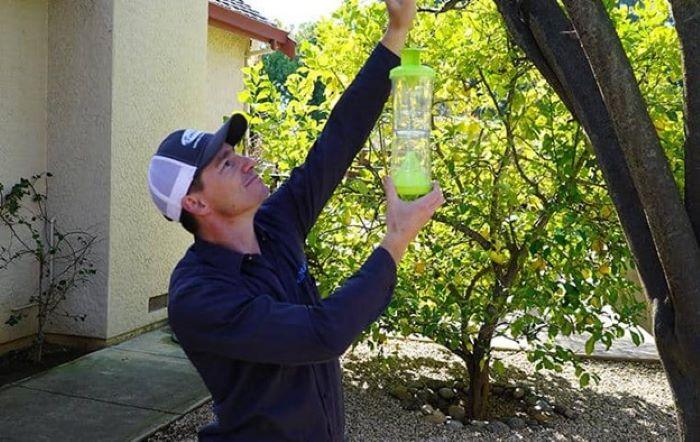
Whether you're allergic to wasp stings or you simply want to send the winged pests packing, we have some effective tips to assist you get rid of wasps both indoors and exterior. These tips utilize to all wasps, including yellow jackets and hornets.
vii Ways to Get Rid of WaspsIn Your Grand
If you have wasps in your thou, these tips can help yous go rid of them:
1. Hang wasp traps
Wasp traps are one of the most common—and effective—ways to get rid of wasps in your thou. The traps feature a liquid that attracts wasps. When the wasps clamber into the trap, they go stuck and drown. While wasp traps are constructive, they accumulate expressionless wasps and can be unsightly to look at. Supervene upon them often and be certain to hang them away from your outdoor living areas.
2. Spray wasp nests
If you see an agile wasp nest effectually your home or holding, spray it with shop-bought wasp nest spray. For best results, article of clothing protective clothing and spray the nest belatedly in the evening, when the wasps are dormant, and the workers and queen are all present. Buy a wasp spray with a nozzle that allows you to spray from a distance. Re-spray the nest repeatedly over the course of a few days, if needed.
3. Utilise soap and water
If you want an alternative to shop-bought insecticides, tackle modest wasp nests with lather and water. Mix two tablespoons of dish soap into a spray canteen of water and spray it on the nests. The mixture will clog the wasps' breathing pores and kill them instantly.
iv. Create homemade traps
Build a homemade wasp trap by cutting the top off a big soda canteen and adding a few inches of soda or fruit juice (with a few drops of dish liquid) to the bottom. Invert and supplant the top and hang the bootleg trap in your yard.
5. Kill emerging wasps
Store-bought wasp killing sprays tin be effective for eliminating individual wasps. Spray wasps as yous see them, being sure to follow all characterization directions on the insecticide you lot buy.
vi. Treat future nesting areas
In addition to sprayingexisting nests, you can care for future nesting areas. Purchase residue liquid insecticides at your local home or hardware store and spray it in the areas where you recollect wasps would nest, such as your deck, pool, patio, playset, and woods fence. This discourages future nest building.
vii. Call a professional person
Getting rid of large outdoor wasp colonies tin can be impossible to DIY. For fast, professional person results, contact Smith's Pest Management. Our squad will remove existing wasps and take steps to forestall new colonies from forming.
How to Get Rid of WaspsIn the House
Wasps indoors can be a major trouble. Here are a few tips to get rid of them:
i. Bank check every entry signal
Unless you lot're leaving your doors and windows open without a screen, wasps are likely entering your home through a tiny gap somewhere. If you lot've noticed wasps indoors, examine your eaves, the mortar betwixt your bricks, the beams and supports in your garage, and the areas around your abode's vents. Wasps tend to build their nests in these areas, and can easily exploit even a tiny fissure to enter your home. Once yous find their access points, seal whatever cracks or gaps with silicone caulk.
ii. Effort effective domicile remedies
If you lot're looking for a natural way to become rid of wasps, there are plenty of home remedies to cull from. One excellent way to get rid of wasps is with vinegar. To create a homemade wasp repellent, mix two cups of apple tree cider vinegar, 2 cups of sugar, and one cup of h2o. Stir the mixture thoroughly and place it near the nest where information technology will concenter and kill wasps.
three. Spray wasp nests
What kills wasps instantly? Wasp spray. Still, we advise caution when using wasp spray indoors. While insecticide is effective, information technology contains chemicals that tin be very dangerous for children, pets, and people. If the nest is in a seldom-used part of your home, spraying it may exist a decent option. If not, y'all're better off calling a pest management professional.
4. Phone call a professional
Dealing with an indoor wasp problem can be unsafe and time-consuming. If your wasp problem is all-encompassing, contact a pest management professional to help you. Smith's Pest Management can remove indoor wasps and assistance yous reclaim your safe wasp-complimentary dwelling.
How to Become Rid of Wasp Nests
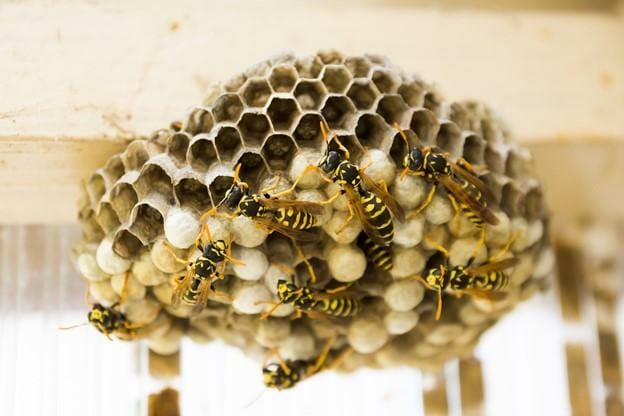
Getting rid of wasp nests seems like a simple job, but it can be circuitous, since aggravated wasps will swarm and sting.
To go along yourself safe and guarantee expert results, e'er spray the nest with shop-bought wasp killer at least 24 hours before trying to remove it. If you still see wasp activity, spray the nest over again.
Once the nest looks quiet, follow these tips:
- Approach the nest in the evening hours once yous're certain all the wasps inside it are dead
- Use a garbage purse to comprehend the nest
- Gently pull the nest from the tree or wall it's attached to, and seal the bag around it
- Throw the garbage bag and the nest away in an outdoor trash can with a tight-fitting chapeau
If the nest is in a difficult-to-reach area, don't try to remove it yourself. Instead, contact Smith'southward Pest Direction to remove the nest safely for you.
How do Pest Control Experts Get Rid of Wasps?
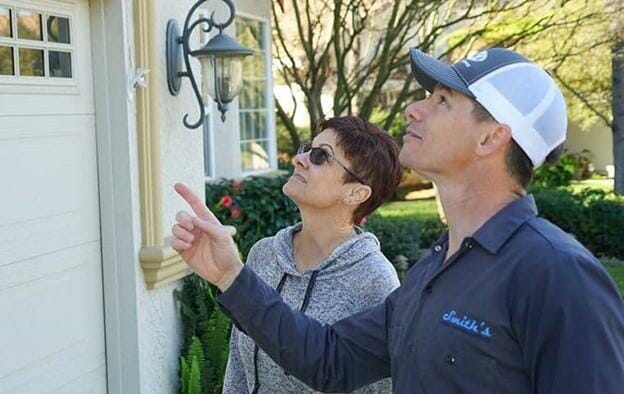
What happens when you contact a professional person wasp control practiced? Here'southward the process the squad here at Smith'south follow to get rid of wasps:
i. Property Inspection
First, we'll locate the wasp nests on your property. Our licensed pest control techs will identify ground or hanging nests and determine the best fashion to remove all the wasps that live within them.
If yous take multiple kinds of wasps on your property, we'll identify each species and create a customized treatment plan to address them.
ii. Destroy Wasp Nests
Once nosotros've located the wasps on your property, nosotros'll treat the nests with a substance designed to eliminate the wasps inside their nests. Nosotros e'er apply the utmost circumspection with pest-control substances, and make sure to use every product co-ordinate to label directions.
iii. Apply Additional Yellowish Jacket Treatments
Finally, we'll apply treated bait around your property. This of import stride allows us to eliminate wasps that were not in the nest during the time of treatment. When yellowish jackets eat the bait, it kills them quickly without putting your property, pets, or kids at risk.
4. Annual Yellow Jacket Control
If you have severe yellowish jacket issues, nosotros'll recommend an annual yellowish jacket control program. This solution includes the installation of allurement stations, unlimited hive treatments, and year-round protection against these aggressive pests. The result is a pest-free property that you can savor all year long.
How to Keep Wasps Away
Wondering how to continue wasps from building nests on your property? Follow these tips:
- Remove food sources. Become rid of all fallen fruit and berries from effectually outdoor fruit trees, clean upward nutrient scraps rapidly, hang hummingbird feeders at a distance from your habitation, and avoid leaving pet food outdoors. Seal all outdoor garbage cans tightly and embrace compost piles. Remember that wasps aren't picky about their food sources, and they'll swallow both protein-rich and sugary foods.
- Seal all doors and windows (or install screens). Use caulk to fill pocket-size gaps or crevices around your property to prevent wasps from entering your domicile. If you accept screens on your windows and doors, brand sure that they're in good repair, since wasps can fit their bodies through even miniscule holes.
- Use wasp-repellent plants. Instead of planting flowers effectually your porch, constitute wasp-deterrent plants like pennyroyal, marigold, wormwood, mint, basil, and geranium.
- Stay vigilant nearly nests. It's impossible to remove wasps entirely, so you have to stay vigilant about nest germination. Each spring, bank check your wall cavities, sheds, and garages for signs of new nests. Every bit presently as you observe them, care for them with store-bought insecticide spray and remove the nest shell.
- Cover or care for holes. If yous notice large or small holes in cement or grass, fill them quickly. Solitary wasps volition look for open cavities in which to make their homes.
- Use natural remedies. Use herbs and essential oils to deter wasps. A combination of clove, lemongrass and geranium essential oils is ideal for applying to outdoor walls, crevices, or other places y'all've noticed wasp activity. Peppermint oil is also an effective wasp repellent.
Are Wasps Invading Your San Francisco Bay Expanse Property? We're Hither to Help!
Here at Smith's Pest Management, we help residential and commercial properties in Northern California, from Marin to Monterey, get rid of wasps every day.
Let us help you relish a wasp-free outdoor infinite this summer.
Contact us today to schedule your wasp removal service.
Source: https://smithspestmanagement.com/blog/post/how-to-get-rid-of-wasps/
0 Response to "Best Way to Kill a Wasp in My House"
Post a Comment